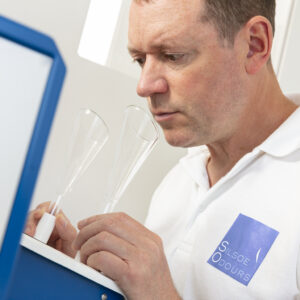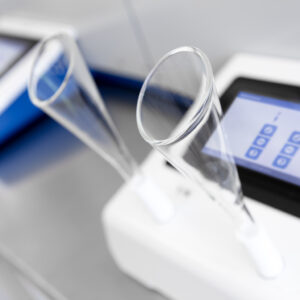AN OVERVIEW OF ODOUR TESTING

The business of ‘smelling’ is undoubtedly unusual. So at Silsoe Odours, we get many questions about what is involved. Are you curious about the process of odour testing and how the odour panel fits within it? Or, as we affectionately know them – sniffers! They are blessed with a particular sense of smell, together with a willingness to put their nose where nobody else dares to. Here is everything you need to know about odour testing and how the process works…
A REPRESENTATIVE SAMPLE OF THE POPULATION
Can you sniff out a jam doughnut at 100 paces? Or maybe you are oblivious to the delights of the perfume department at duty-free? If that sounds like you, you will not cut it as an odour tester at Silsoe Odours. Contrary to popular belief, we are on the lookout for average. We conduct olfactometry analysis here at our laboratory in Bedfordshire. Our results must be consistent with the population’s average sensitivity to smell. In other words, our odour panel forms a representative group of the population. We have a stringent selection process (supported by ongoing testing) to ensure panel members fit within a specific range of odour sensitivity.
THE ROLE OF THE SNIFFER

We can analyse samples for several features and characteristics
Primarily, our odour panel is responsible for analysing an odour once it has been collected from a site, although they do get out and about on site too for ‘sniff surveys’.
Our UKAS-accredited sampling team usually collect the samples by way of an odour sampling survey. However, many clients also send us samples they collect themselves, using our ‘lab only’ service.
Generally speaking, our most popular odour testing service is odour concentration testing. But our clever bunch of sniffers also test samples for other features and characteristics. For example, we can analyse samples for odour characterisation (what it smells like), intensity (how strong it is) and hedonic tone (how pleasant it is).
OBJECTIVE ODOUR TESTING
Only 1 in 3 applicants for a Silsoe Odours sniffer role are successful. We look for the most objective, consistent data output possible. The laboratory team select odour panel members using testing in line with the European Standard BS EN13725.
The odour testing laboratory is UKAS accredited. So you can rest easy on the quality of our results.
Furthermore, our odour testers work in teams of six, to ensure the highest possible level of objectivity.
A TRUSTWORTHY NOSE

Odour Panel Member, Chris, has a very reliable nose!
Repeatability is critical in our lab. It is the most crucial element for our odour panel members. This is because a changeable nose makes odour testing results inconsistent. With this in mind, we put our sniffers through their paces regularly. In this way, we ensure their sniffing senses remain consistent. There is a lot to be said for a trustworthy nose (ask any pup!).
HOW DOES ODOUR TESTING WORK?
To measure the concentration of an odour, we present a panel of six sniffers with two samples. The first is a dilution of the odour sample, and the second is a sample of clean air.

Panel members analyse odours using sniffing ‘horns’ connected to an olfactometer.
We use sniffing ‘horns’ connected to an olfactometer (a specialist laboratory instrument) to do this. The panel then selects which horn contains the odour through a ‘forced-choice’ assessment. They must specify whether their answer is a guess, inkling or certain choice.
We repeat the process with increasingly higher concentrations of odour. We only stop when all six panel members are certain the odour is present on two successive occasions. The final output gives each sniffer an individual threshold estimate.
Finally, we calculate the results to give us the geometric mean of the odour concentration in the sample.
WHAT’S THE STINK?
You are probably wondering what kind of thing we come across when odour testing. Well, the most common odour our team encounters is from sewage works. But they could also be faced with anything from leather to rotten eggs to pet food. Ordinarily, it is really not as bad as it sounds though. Honest.
COMMITTED TO THE ODOUR TESTING CAUSE
Our odour laboratory is far from your average workplace. In fact, it is entirely odour free. And that is trickier to achieve than you might think. We task all our odour panel members with strict requirements. For instance, they must not use fabric softeners or conditioners on their clothes or wear perfume or aftershave.
But don’t worry; we keep things fresh with our trusty air conditioning system. Sniffers also leave their teas and coffees outside and avoid stinky foods before coming in. We even banished glossy magazines, as there is a scent in the ink that can impact the odour testing results.
With new safety requirements, we have also had to be very specific about our choice of hand sanitiser. We made sure it has a high concentration of alcohol to be effective whilst – of course – being odour free.
ODOUR SENSITIVITY TESTING
So, do you fancy having a go yourself? If so, take a look at our odour sensitivity testing service. You can compare your personal odour sensitivity with the population average. Or in the case of odour complaints, with the complainant’s odour sensitivity. You will find it helpful if you are involved in monitoring odours, whether for a specific site, for planning purposes or from a regulator perspective.
It also gives you an excellent opportunity to check out our UKAS-accredited odour laboratory. And don’t worry; we will not subject you to anything too stinky. We keep it strictly to n-Butanol, the reference gas. All tests are compliant with European Standard BSEN13725.
REFERENCES
Institute of Air Quality Management (IAQM)
Guidance on the assessment of odour for planning
Environment Agency
Additional guidance for H4 Odour Management – how to comply with your environmental permit
Re-published from ‘Odour Testing – The Importance of Odour Assessors’ blog, dated March 2018. Updated 26th January 2023.

2 Responses
[…] samples are in safe hands. They’re tested by our fully trained (and frequently tested) panel of odour assessors, to the European Standard EN13725. There are a number of different things we can test for, […]
Seeing how the testing process is done is really quite interesting. Now it does make sense that you’d want something like this done at a place where you don’t want a certain smell to present. As you said, doing this would be a good way to figure out where the smell is coming from and what is causing it.